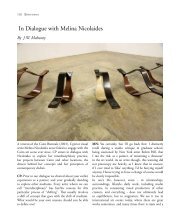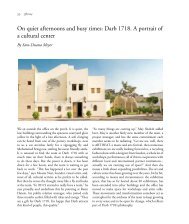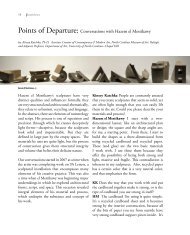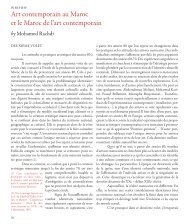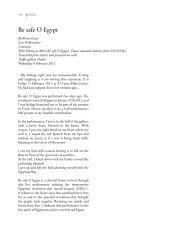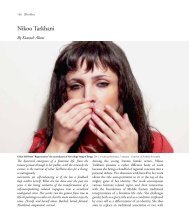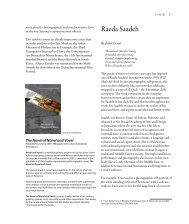abu dhabi international sculpture symposium 2010 - Contemporary ...
abu dhabi international sculpture symposium 2010 - Contemporary ...
abu dhabi international sculpture symposium 2010 - Contemporary ...
You also want an ePaper? Increase the reach of your titles
YUMPU automatically turns print PDFs into web optimized ePapers that Google loves.
Reviews<br />
107<br />
which is a very different sensation from that<br />
experienced at distance. The interior void has a<br />
wonderful surprise of light and a sense of comfort<br />
which engages the viewer on an intimate level<br />
and yet at the same time is inaccessible. The idea<br />
of accessibility and interaction is what Masahiro<br />
Hasegawa’s Lotus is about. It is an invitation to<br />
walk through and under nine elegant stainless<br />
steel lotus pads ranging from one metre to<br />
nine metres. The lotus pads are laid out in a<br />
meticulous and precise arrangement as in most<br />
traditional Japanese gardens. At the same time,<br />
Lotus has an imaginative playfulness about it.<br />
It has a contemporary “Alice in Wonderland”<br />
adventurousness, especially with the placement<br />
of a number of crystal clear glass drops on the<br />
rims of the pads. One cannot help but think<br />
that there is a playful side to what may at first<br />
seem traditional.<br />
Spanish artist Juanjo Novella eloquently<br />
suggests interaction and engagement on both<br />
the physical and conceptual levels in Durango,<br />
which has many layers to unravel. The paradox<br />
Novella creates raises interesting issues regarding<br />
our urban environment. The <strong>sculpture</strong> stands<br />
by itself and yet its presence is defined by its<br />
environment. The one-inch thick plate is a<br />
modern industrial material, and yet in his hands,<br />
it is transformed into something as delicate,<br />
vulnerable and intricate as might be found in<br />
nature’s living and breathing surroundings. The<br />
environment and structure are synonymous<br />
in that one cannot see and experience one<br />
without being aware of the other. The scale is<br />
monumental while its seductive accessibility<br />
allows for an engagement of intimacy.<br />
At first glance, Herald , by Korean artist Seung-<br />
Woo Hwang, seems to merely mimic a stack<br />
of books, but upon closer examination one<br />
Gheorgi Filin (Bulgaria)_SAILING IN THE DESERT<br />
experiences a hint of an underlying suggestion<br />
of the intentional monotony of our daily<br />
preoccupations. The careful monotonous<br />
repetition of cutting what might be endless<br />
edges of the pages of books cannot help but<br />
make us think about the value or point of daily<br />
rituals and their repetition. It poses questions<br />
about our daily engagement with paper on all<br />
levels. Hwang’s <strong>sculpture</strong> is deceptive, as what<br />
may appear to be obvious is indeed exactly<br />
what he is pointing out and thus, he questions<br />
its validity. This is an interesting way of dealing<br />
with abstract ethereal concepts through a solid<br />
traditional monolithic material such as stone.<br />
Elusive Cycles , by Billy Lee, is a striking fivemetre<br />
polished stainless steel <strong>sculpture</strong> and<br />
is the only piece that has directly engaged the



